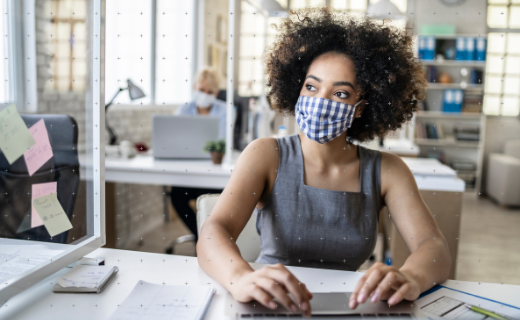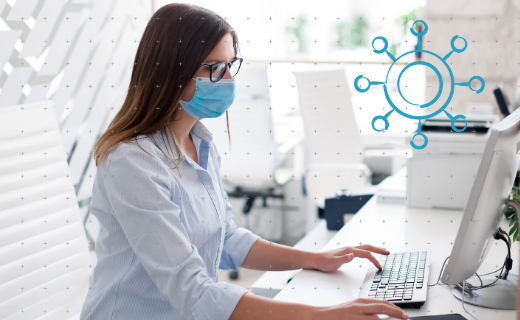When things start to return to normal, how will you return to work safely?
Staying open or re-opening during the COVID-19 pandemic has brought with it a number of challenges. California’s new law, AB-685, is now set to introduce a new set of rules, which businesses must adhere to when they decide to allow employees and visitors to return. This will include a requirement to store Personal Health Information (PHI) about anyone entering the facilities.
Keeping track of this information could become a huge task. Square 9 has been designed to solve this. The system houses all of this information in one place, so you can protect not only your employees, but also your business.
What is AB-685?
AB-685 is an extension of the existing 1973 OSHA law. This extension will come into effect on January 1st 2021 and will bring with it new requirements for employers to notify employees and their unions about potential COVID-19 exposure in the workplace. No matter what type of business you have, all employees (public or private) must report to public health officials within one business day of any potential exposure to COVID-19. AB-685 also relaxes the pre-citation requirements that Cal OSHA must follow before issuing a citation for a serious violation related to COVID-19.
During the pandemic, all employers have been advised to notify any employees who may have been in close contact with an infected employee. Cal OSHA published guidelines on protecting workers from COVID-19, which states that if employers learn about a confirmed onsite case, the employer should inform employees of their possible exposure. It’s important to note that confidentiality should always be maintained as required by the ADA. The California Department of Public Health also issued a draft communication, which employers can send to employees who have been potentially exposed.
With the introduction of AB-685, this requirement to notify employees who may have been exposed to an infected employee is now mandatory for all public and private businesses under the new Labor Code section 6409.6.
Section 6409.6(a) requires an employer or representative of the employer, who receives “notice of potential exposure” to COVID-19, to take the following actions within one business day.
-Notify potentially infected employees
-Notify the union about potentially infected employees
-Notify potentially infected employees and their union of COVID-19 related benefits
-Notify all employees and their union of the employer’s COVID-19 safety plan
AB-685 will also require employers to maintain records of these notifications for at least three years.
What does this mean for your business?
As our current situation is constantly changing, it can be difficult to define exactly what you need to do when re-opening your business. The target moves as the pandemic evolves. However, there are some key recommendations which have remained consistent throughout. Here’s a brief framework you can follow:
- Make sure you have a solid set of screening practices in place
- Make sure all of your employees are clear on what they need to do to be compliant
- Make sure your risk management plan is secure and thorough
- Take the temperature of anyone entering your facility*, including:
- Employees
- Vendors
- Visitors
- Contractors
*It’s universally agreed that a fever of 100.4 or more is a symptom of COVID-19.
By combining temperature monitoring with proper health screening, you can help reduce the spread of COVID-19, while remaining open and continuing to operate your business.
When you welcome people back to your facilities, keep this mantra front of mind: “Be compliant, mitigate risk, and protect the organization”.
How should you document these policies and procedures?

It’s important that your employees are aware of what you’re doing to protect them and what they can expect moving forward. Here are a few key points to follow:
- Create a written policy of practices which have been accepted by your employees.
- Make sure the practices you’re introducing are universally applied across the business.
- Make sure you don’t engage in disparate treatment based on the protected class of your employees.
- Involve the HR team in the creation of these policies to ensure they’re people-focused and business-focused.
How can you store all of the information you’re collecting so you can accurately report it to local health officials?
These new compliance requirements will involve the collection of a huge amount of information, which can be quite overwhelming. The best way to mitigate this is to employ a system to store all of this information in one secure place. This means if you ever do need to report it to local health officials, you’ll know exactly where to look. Square 9 software provides an easy-to-use system which houses all of your screening questionnaires and results in a HIPAA, SOC1, and SOC2 compliant cloud-based server.
When you collect screening information, there are a few basic questions you should ask. Most people should be familiar with these questions by now, as many of the open businesses are using them.
These questions can be modified but for this solution to work, you must only allow yes/no answers.
- Have you had any recent exposure to COVID-19?
- Are you experiencing any symptoms, such as a cough, a fever, or a runny nose?
- Have you recently been quarantined due to exposure?
- Have you traveled outside of the continental US recently?
What are the benefits to using this system?
Square 9 solves the problem of having to create a system manually and the secure process means you’ll be able to easily identify and report exposure to employees and local health officials. No lost information or mountains of paperwork. The “PHI”, or Personal Health Information, you collect will be safe and secure, as it will all be stored in Square 9’s Cloud.
If you do decide not to opt for Square 9 and to house the PHI (Personal Health Information) on your own server instead, you’d need to adhere to the following:
- Any storage of data must be in a HIPAA compliant repository – the data must be secure and encrypted.
- Access to the information must be controlled and logged.
- There must be a compliant remediation plan in the event of a data breach.
- You would need to invest in an audit for HIPAA.
As an additional layer to protect yourself from unwarranted litigation related to potential COVID-19 exposure, you can also incorporate a liability waiver. This is optional and can be seamlessly added to Square 9’s health screening workflow. The visitor will be required to acknowledge that exposure is still possible, despite the thorough steps taken to protect them. This waives any responsibility by the business, its officers, directors, and staff for any unintended exposure.
How does Square 9 work?
The process is simple. The screening questions on Square 9 can be accessed by visitors using a QR code. They don’t need to download an app – they can use their standard phone camera to hover over the QR code. This will then prompt them to open the Square 9 website to answer the screening questions.
The solution is included in the Square 9 Cloud bundle, which meets HIPPA regulations. You can also choose to host the solution on your own server, but you will then be responsible for meeting the HIPPA regulations.
Come January 1st, AB-685 will be the new reality for businesses in California, so it’s important to be prepared for COVID-19 exposure in your workplace. You need a plan in place to keep your business and your staff safe and a secure location to store all of the information you collect. This is where Square 9 comes in. If you’re interested in learning more about the solution, contact us today at [email protected].

